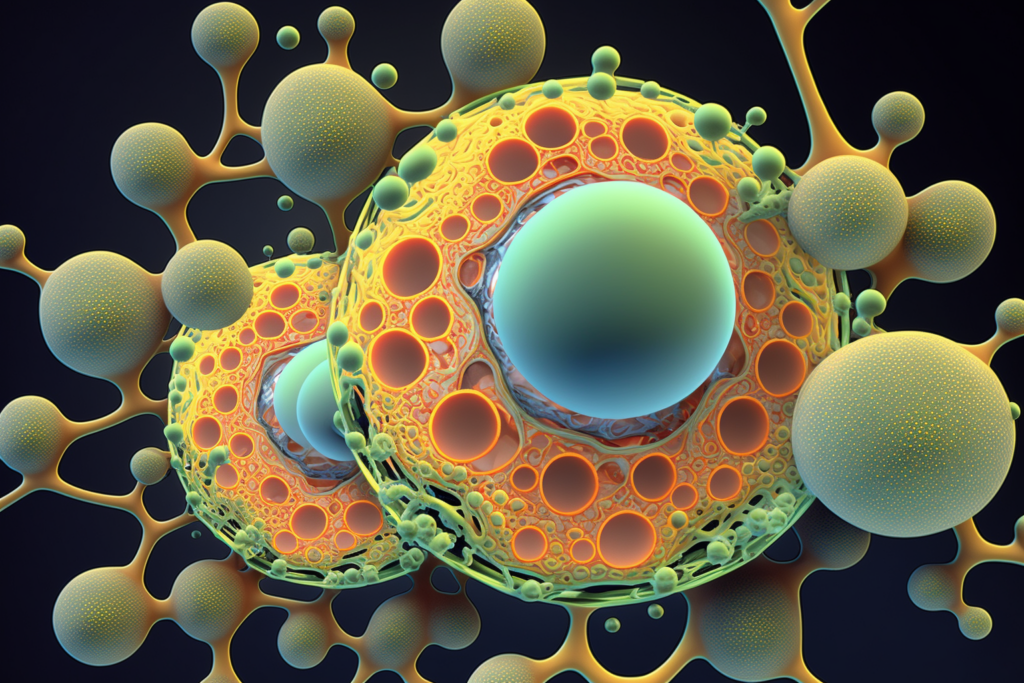
What are Induced Pluripotent Stem Cells?
iPSCs are stem cells that have been generated by scientists through a process of cellular reprogramming, allowing any type of cell to be converted into an iPSC.
They can be derived from adult somatic cells, such as skin or blood cells, and reprogrammed using a variety of techniques to change their genetic makeup and revert to an embryonic-like state, supporting them in their growth as they develop into any cell type the body requires and making them one of the top stem cell based therapies to consider.
iPSCs have become a popular area of stem cell research because they offer the potential for regenerative therapies and drug development, as well as provide an alternative to embryonic stem cells.
How are iPSCs Created?
The creation of induced pluripotent stem cells (iPSCs) is a process that involves taking adult cells and reprogramming them into a state where they can develop into any type of cell in the body.
This is accomplished by introducing specific genes that induce pluripotency into the adult cells. The reprogrammed cells can then be used to produce different types of cells for use in various therapies.
The use of iPSCs in therapy is becoming increasingly popular due to their ability to produce specific cell types without the ethical concerns associated with embryonic stem cells.
Advantages of iPSCs over Embryonic Stem Cells
There are several advantages of using iPSCs over embryonic stem cells.
One of the main advantages is that iPSCs can be created using a patient’s own cells, which reduces the risk of rejection by the immune system. This makes iPSCs a promising candidate for personalized therapy.
In contrast, embryonic stem cells are derived from embryos, which raises ethical concerns, and also have a greater risk of rejection as they are derived from a different donor.
Potential Applications of iPSC Therapy
The potential applications of iPSC therapy are numerous.
Neurological Disorders

The potential applications of induced pluripotent stem cells (iPSCs) for neurological disorders are numerous and promising.
Neurological disorders are conditions that affect the brain, spinal cord, and nerves, and can have a significant impact on a person’s quality of life.
iPSCs can be reprogrammed into different types of brain cells, which can then be transplanted into the brain to replace damaged or dead cells. This cell therapy approach holds great promise for the treatment of a wide range of neurological disorders.
Parkinson’s Disease
One neurological disorder that is being explored for iPSC therapy is Parkinson’s disease. Parkinson’s is a degenerative disorder that affects the nerve cells in the brain that produce dopamine.
iPSCs can be reprogrammed into dopamine-producing cells, which can then be transplanted into the brain to replace the damaged or dead cells. This approach has shown promising results in animal studies and is currently being tested in clinical trials.
Alzheimer’s Disease
Another neurological disorder where iPSC therapy is being explored is Alzheimer’s disease. Alzheimer’s is a progressive disorder that affects memory, thinking, and behavior.
iPSCs can be reprogrammed into different types of brain cells, including neurons and astrocytes, which are involved in the progression of Alzheimer’s disease.
Transplanting these cells into the brain could potentially slow or halt the progression of the disease.
Huntington’s Disease & ALS
Other neurological disorders where iPSC therapy is being explored include Huntington’s disease, amyotrophic lateral sclerosis (ALS), and spinal cord injuries. iPSCs can be reprogrammed into different types of brain and spinal cord cells, which can then be transplanted into the affected areas to replace damaged or dead cells. This approach has shown promising results in animal studies and is currently being tested in clinical trials.
Cardiovascular Diseases

Induced pluripotent stem cells (iPSCs) have the potential to revolutionize the treatment of cardiovascular diseases, which are conditions that affect the heart and blood vessels.
iPSCs can be reprogrammed into different types of heart cells, including cardiomyocytes and endothelial cells, which can be used to repair damaged tissue and improve heart function.
The potential applications of iPSC therapy for cardiovascular diseases are numerous and promising.
Heart Failure
One cardiovascular disease that is being explored for iPSC therapy is heart failure. Heart failure is a condition where the heart is unable to pump enough blood to meet the body’s needs. iPSCs can be reprogrammed into cardiomyocytes, which can then be transplanted into the heart to repair damaged tissue and improve heart function.
Myocardial Infarction
Another cardiovascular disease where iPSC therapy is being explored is myocardial infarction, commonly known as a heart attack.
When blocked arteries impede the oxygen-rich blood from reaching your heart, a cardiac event known as a heart attack occurs. This blockage of essential nutrients can weaken or destroy parts of the vital organ, leading to potential long-term consequences if not treated promptly. iPSCs can be reprogrammed into cardiomyocytes, which can be transplanted into the heart to replace the damaged tissue.
Other cardiovascular diseases where iPSC therapy is being explored include peripheral artery disease, atherosclerosis, and congenital heart disease. iPSCs can be reprogrammed into different types of heart and blood vessel cells, which can then be transplanted into the affected areas to repair damaged tissue and improve blood flow.
Diabetes

Diabetes is a chronic disease that affects the way the body processes blood sugar. There are two types of diabetes: type 1 and type 2.
Type 1 diabetes is a persistent autoimmune condition where the immune system attacks and eliminates insulin-producing cells present in the pancreas.
This attack on the pancreas ultimately leads to a deficiency of insulin, a hormone essential for regulating blood sugar levels in the body.
Type 1 diabetes can develop at any age, but it is most commonly diagnosed in children, adolescents, and young adults. This disease is managed by regular monitoring of blood sugar levels and insulin therapy to replace the missing hormone.
Type 2 diabetes is a condition where the body becomes resistant to insulin. iPSCs have the potential to revolutionize the treatment of diabetes by providing a new way to replace damaged or destroyed insulin-producing cells with healthy ones.
One potential application of iPSC therapy for diabetes is the production of insulin-producing cells. iPSCs can be reprogrammed into cells that produce insulin, which can then be transplanted into the pancreas to replace the damaged or destroyed cells.
Another potential application of iPSC therapy for diabetes is the production of cells that regulate blood sugar levels. iPSCs can be reprogrammed into cells that secrete hormones such as glucagon-like peptide 1 (GLP-1) and peptide YY (PYY), which play a key role in regulating blood sugar levels. These cells can then be transplanted into the gut, where they can help to regulate blood sugar levels and improve insulin sensitivity.
Other potential applications of iPSC therapy for diabetes include the production of cells that protect against the complications of diabetes, such as retinopathy and neuropathy. iPSCs can be reprogrammed into cells that produce growth factors and other molecules that can protect against the damage caused by high blood sugar levels. These cells can then be transplanted into the affected areas to promote healing and prevent further damage.
Benefits and Risks of Induced Pluripotent Stem Cell Therapy
Benefits of iPSC Therapy
iPSC therapy has the potential to revolutionize the field of regenerative medicine by providing a new way to replace damaged or diseased cells with healthy ones.
Personalized Treatment
One of the most significant benefits of iPSCs is the potential for personalized treatment.
iPSCs can be created from a patient’s own cells, such as skin cells or blood cells, and then reprogrammed into different types of cells that can be used to treat a wide range of conditions.
This approach has the potential to provide personalized treatments that are tailored to the specific needs of each patient, improving the safety and effectiveness of the therapy.
By using a patient’s own cells to create iPSCs, the risk of rejection is reduced, which can improve the safety and efficacy of the therapy.
Personalized iPSC therapy also has the potential to reduce the need for immunosuppressive drugs, which are often used to prevent the rejection of transplanted stem cells.
Another benefit of personalized iPSC therapy is the potential for disease modeling and drug development. iPSCs can be created from patients with specific diseases, and then used to study the disease and test potential treatments.
This approach has the potential to accelerate the development of new treatments for a wide range of conditions, by providing a more accurate model of the disease and enabling researchers to test potential treatments more quickly and effectively.
Overall, the potential for personalized treatment using iPSCs is one of the most exciting and promising aspects of this technology.
Risks of iPSC Therapy
Despite the potential benefits of iPSC therapy, there are also some risks associated with this approach.
Tumor Formation
One of the potential risks associated with induced pluripotent stem cells (iPSCs) therapy is the development of tumors.
iPSCs can divide and differentiate into different types of cells, which can lead to the formation of tumors if they are not properly controlled.
This risk is a significant concern for iPSC therapy, as the formation of tumors can be life-threatening and may limit the effectiveness of the treatment.
Several factors can contribute to the risk of tumor formation with iPSC therapy, including the method used to reprogram the cells, the quality of the cells used, and the method of delivery.
For example, some methods of reprogramming iPSCs can lead to the activation of cancer-causing genes, which can increase the risk of tumor formation.
Additionally, the use of low-quality cells or the delivery of iPSCs in an uncontrolled manner can increase the risk of tumor formation.
To mitigate the risk of tumor formation with iPSC therapy, researchers are exploring a range of strategies, including the use of higher-quality cells, the development of more precise reprogramming methods, and the use of targeted delivery methods.
Researchers are also exploring ways to monitor the cells after transplantation, to ensure that they are not forming tumors.
Genetic Abnormalities
One of the potential risks associated with induced pluripotent stem cells (iPSCs) therapy is the risk of genetic abnormalities.
iPSCs are created by reprogramming adult cells, which can result in changes to the cells’ DNA. These changes can include mutations, epigenetic changes, and chromosomal abnormalities, which can increase the risk of genetic diseases and disorders.
This risk is a significant concern for iPSC therapy, as the use of genetically abnormal cells can limit the effectiveness of the treatment and pose a risk to the patient’s health.
Several factors can contribute to the risk of genetic abnormalities with iPSC therapy, including the method used to reprogram the cells, the quality of the cells used, and the genetic stability of the resulting iPSCs.
For example, some methods of reprogramming iPSCs can result in the activation of genes associated with cancer or other genetic diseases. Additionally, the use of low-quality cells or the use of cells with pre-existing genetic abnormalities can increase the risk of genetic abnormalities in the resulting iPSCs.
To mitigate the risk of genetic abnormalities with iPSC therapy, researchers are exploring a range of strategies, including the use of higher-quality cells, the development of more precise reprogramming methods, and the use of gene editing techniques to correct genetic abnormalities.
Researchers are also exploring ways to monitor the cells after transplantation, to ensure that they are not developing genetic abnormalities.
Immunogenicity
Finally, one other potential risk associated with induced pluripotent stem cells (iPSCs) therapy is the risk of immunogenicity.
Immunogenicity refers to the ability of a foreign substance to provoke an immune response in the body.
When iPSCs are transplanted into the body, the immune system may recognize them as foreign and mount an immune response, which can limit the effectiveness of the therapy and pose a risk to the patient’s health.
Several factors can contribute to the risk of immunogenicity with iPSC therapy, including the method used to reprogram the cells, the quality of the cells used, and the method of delivery.
For example, some methods of reprogramming iPSCs can result in the activation of genes associated with immune response, which can increase the risk of immunogenicity. Additionally, the use of low-quality cells or the delivery of iPSCs in an uncontrolled manner can increase the risk of immunogenicity.
To mitigate the risk of immunogenicity with iPSC therapy, researchers are exploring a range of strategies, including the use of patient-specific cells, the development of more precise reprogramming methods, and the use of immunosuppressive drugs to prevent rejection of the transplanted cells.
Researchers are also exploring ways to monitor the immune response after transplantation, to ensure that the cells are not being rejected.
Latest Research on Induced Pluripotent Stem Cells Therapy

Current State of iPSC Therapy Research
The field of induced pluripotent stem cell (iPSC) therapy is rapidly evolving, with ongoing research focused on improving the safety and efficacy of this approach.
Clinical Trials and Studies
One important area of research is clinical trials and studies. These trials are designed to evaluate the safety and effectiveness of iPSC therapy in humans.
Several clinical trials have been conducted or are currently underway to test the safety and efficacy of iPSC therapy for a variety of conditions, including heart disease, Parkinson’s disease, and spinal cord injury.
Recent Breakthroughs and Developments
In addition to clinical trials, there have been several recent breakthroughs and developments in iPSC therapy research.
For example, researchers have developed new techniques for creating iPSCs that are more efficient and less prone to genetic abnormalities.
They have also developed new methods for differentiating iPSCs into specific cell types that are more effective at treating certain conditions.
These advances are helping to improve the safety and effectiveness of iPSC therapy and are paving the way for new treatments for a wide range of diseases.
Challenges in iPSC Therapy Research
Despite these advances, there are still several challenges facing iPSC therapy research.
Reprogramming Efficiency
One major challenge is reprogramming efficiency. While the process of creating iPSCs has become more efficient in recent years, it is still not perfect.
Researchers are working to improve the efficiency of the reprogramming process so that iPSC therapy can become more widely available and affordable.
Safety and Efficacy
Another challenge in iPSC therapy research is safety and efficacy.
While iPSCs have the potential to provide personalized and effective treatments, there are still concerns about the safety of these cells.
For example, iPSCs have been shown to have the potential to form tumors, which could be a significant safety concern.
Additionally, there is still much to be learned about the long-term safety and efficacy of iPSC therapy.
In conclusion, iPSC therapy research is rapidly evolving, with ongoing clinical trials and studies, as well as recent breakthroughs and developments.
While there are still challenges facing this field, researchers are making significant progress in improving the safety and efficacy of iPSC therapy.
As this research continues, iPSC therapy has the potential to provide personalized and effective treatments for a wide range of diseases, revolutionizing the field of regenerative medicine.
Click here to find out more about other types of stem cell therapies.
*** All content on NationalStemCellTherapy.com is for informational purposes only. All medical questions and concerns should always be consulted with your licensed healthcare provider.
